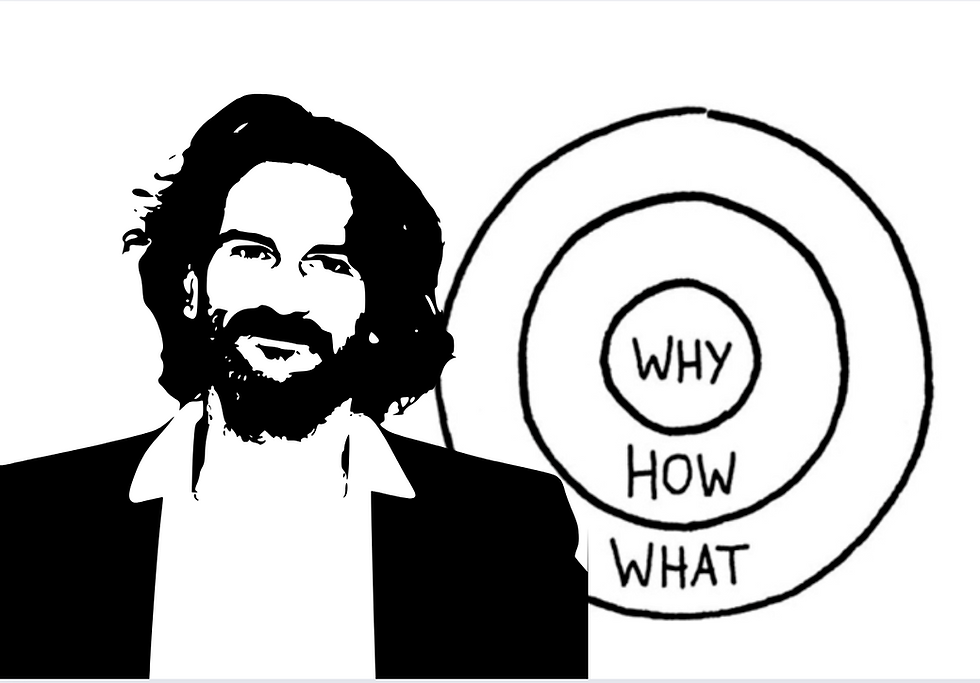Beigbeder vs. Sinek: Two Sides of the Same Brand Dream?
- Eleonora Guido
- Jul 23
- 3 min read
Today, I want to explore a curious parallel between two voices that have shaped the way we think about advertising and branding.
On one side, we have Frédéric Beigbeder—a former ad man turned novelist, known for his brutally honest critique of the industry. On the other, we have Simon Sinek, whose Golden Circle framework has inspired thousands of entrepreneurs to find their “Why.”
At first glance, these two couldn’t be more different:Beigbeder tears down illusions; Sinek invites us to build them.But what happens if we pause and consider both views side by side?
Maybe, just maybe, they’re talking about the same thing.

Beigbeder and the Cynicism of Advertising
In his cult book 99 Francs (titled “€14.99” or “Windows on the World” in English), Beigbeder delivers one of the most cutting and unforgettable critiques of the ad world:
“I'm an ad man: yes, I pollute the universe. I sell you crap. I make you dream about things you'll never have. I hook you on novelty—because there’s always something newer to make the previous new feel old. Making you drool is my job. In my profession, no one wants you to be happy. Happy people don’t consume.”
Provocative? Absolutely.But also uncomfortably honest.
Beigbeder doesn’t claim advertisers sell products. They sell dreams, illusions, promises of better, more fulfilled lives through objects that rarely live up to those expectations.And if we’re being honest—as marketers and as consumers—we know he’s not entirely wrong.
Sinek and the Power of Purpose
Now let’s switch lenses.
Simon Sinek takes a completely different view. His concept of the Golden Circle is built on one foundational belief:People don’t buy what you do. They buy why you do it.
His framework breaks down into three levels:
Why – The belief that drives your company
How – The process or differentiator
What – The actual product or service
Sinek points to Apple as the perfect example. Apple doesn’t just sell devices—it sells a philosophy: innovation, creativity, and thinking differently. The products are simply physical manifestations of that belief.
Another case?Nike doesn’t just sell sneakers. It inspires us to push our limits. Just do it is more than a slogan—it’s an identity.
In Sinek’s world, the “Why” is what builds emotional connection and long-term loyalty.
Beigbeder vs. Sinek: A False Opposition?
At first glance, they seem to speak entirely different languages.
Beigbeder tells us branding is a dream machine.
Sinek tells us branding is a belief system.
But what if they’re both right?
When we say we believe in Apple’s innovation, but still buy the latest MacBook—it’s not just because of the product. It’s because of what it represents.When we wear Nike, maybe we don’t run faster—but we feel like we could.
So is the “Why” truly authentic—or do we just want it to be?
Maybe we don’t need brands to be real.We just need them to make us believe in something—for a moment.
The "Why" Might Be a Dream—and That’s Okay
Here’s the heart of it:The “Why” isn’t just useful for brands. It’s useful for us.
We want to feel part of something greater.We want to wear values.We want to believe we’re a little better, braver, bolder—just by choosing a certain product.
It’s not always rational.It’s emotional, aspirational, and deeply human.
Whether it’s Beigbeder’s cynical realism or Sinek’s hopeful vision, they both acknowledge the same truth:We buy into dreams. And we like it that way.
Let Your Brand Find Its Balance
If you work in branding or communication, ask yourself:How can your brand strike the balance between sincerity and aspiration?
Your “Why” doesn’t have to be perfect.
Your storytelling doesn’t have to be flawless.
But it does need to be felt.
Because in the end, whether it's Beigbeder’s honesty or Sinek’s optimism, what matters is simple:
Make people believe. Even just for a moment.accontare la tua storia per connetterti con il tuo pubblico, senza dover rinunciare alla trasparenza?




Comments